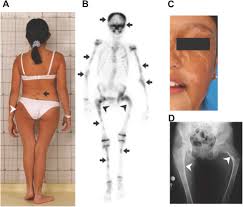
 McCune–Albright syndrome is a complex genetic disorder affecting the bone, skin and endocrine systems.
McCune–Albright syndrome is a complex genetic disorder affecting the bone, skin and endocrine systems.
McCune–Albright syndrome is estimated to occur at a frequency between 1 person in 100,000 to 1 person in 1,000,000 individuals worldwide.
Cushing syndrome is very rare, and is typically diagnosed clinically in infants who present with signs of severe illness.
It is a mosaic disease arising from somatic activating mutations in GNAS, which encodes the alpha-subunit of the Gs heterotrimeric G protein.
Genetically, there is a spontaneous postzygotic mutation of the gene GNAS, on the long (q) arm of chromosome 20 at position 13.3, that is involved in G-protein signaling.
This mutation, leads to constitutive receptor signaling and inappropriate production of excess cAMP.
The somatic mutation in GNAS results and stimulation of endocrine function.
McCune–Albright syndrome is suspected when two or more of the following features are present:
Fibrous dysplasia
Hyperpigmented skin lesions
Precocious puberty: The most common endocrinopathy is precocious puberty, which presents in girls (~85%) with recurrent estrogen-producing cysts leading to episodic breast development, growth acceleration, and vaginal bleeding.
Precocious puberty may also occur in boys with McCune–Albright syndrome, but is much less common (~10–15%).
In children of both sexes, growth acceleration may lead to tall stature in childhood, (premature bone maturation may lead to early growth plate fusion and short stature in adulthood).
Testicular abnormalities: are seen in a majority (~85%) of boys with McCune–Albright syndrome 9macro-orchidism with Leydig and Sertoli cell hyperplasia.
Hyperthyroidism:occurs in approximately one-third of patients with McCune Albright syndrome.
Growth hormone excess: Excess growth hormone secretion and is found in approximately 10–15% of patients, and may lead to expansion of craniofacial fibrous dysplasia, increasing the risk of vision and hearing loss.
Cushing’s syndrome: In McCune–Albright syndrome, Cushing’s syndrome is a very rare feature found only in infancy.
These lesions presence of hypophosphatemia due to increased fibroblast growth factor 23 production may lead to rickets, osteomalacia, and worsening skeletal outcomes.
The mutation that causes McCune–Albright syndrome arises very early during embryogenesis.
There are no known risk factors for acquiring McCune–Albright syndrome.
No exposures during pregnancy are known to cause or prevent the mutation from occurring.
The disease cannot be inherited and occurs equally among all ethnic groups.
McCune–Albright syndrome has different levels of severity.
All patients with known or suspected McCune–Albright syndrome should undergo a screening evaluation for fibrous dysplasia, and nuclear medicine technetium-99 scintigraphy is the most sensitive way to detect fibrous dysplasia lesions.
CT scan of the skull is the most useful test to evaluate craniofacial fibrous dysplasia.
CT and/or MRI scans can reveal microfractures.
Regular screening for scoliosis should also be undertaken.
Patients with known or suspected McCune–Albright syndrome should undergo a screening evaluation for endocrine features.
Treatment is based both on the tissues affected and the extent to which they are affected.
Surgical intervention may be necessary for some skeletal abnormalities.
Bisphosphonates are helpful in relieving bone pain.
Denosumab has been found successful in reducing bone pain and decreasing tumor growth.
Denosumab hasvlimited safety data available in patients with fibrous dysplasia.
Muscle strengthening exercises help prevent bone fractures; cycling and swimming are recommended in order to reduce the risk of fracture during exercise.
Management of endocrinopathies is an important part of managing fibrous dysplasia: untreated growth hormone excess increases the risk of craniofacial fibrous dysplasia expansion and may lead to vision loss.
Untreated hyperthyroidism and hypophosphatemia increases the risk of fractures and skeletal deformities.
For treatment of precocious puberty, the aromatase inhibitor such as letrozole is effective at prevent bleeding episodes and preventing short stature.
In boys, these should be combined with drugs such as spironolactone and flutamide to treat androgen excess.
Periodic ultrasounds of testicular lesions are performed to screen for cancer.
Hyperthyroidism is managed with medications, however, because hyperthyroidism in McCune–Albright syndrome does not resolve, surgery or radiation are more definitive treatments.
Oral phosphate and calcitriol may be given for treatment of hypophosphatemia.
For growth hormone excess, somatostatin analogues or pegvisomant may be effective.
Excessive prolactin secretion may also occur; this is treated with dopamine agonists such as cabergoline.
Radiation therapy has been associated with malignant transformation of skull base fibrous dysplasia, and should be avoided.
Cushing syndrome is a rare but potentially fatal complication that can occur in the first year of life, and is treated with adrenalectomy.
Metyrapone may also be used for treatment.
